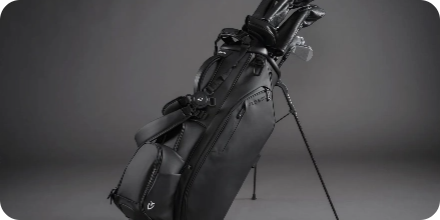The Ultimate Golf Club Guide: Choosing the Right Set for Your Game
Posted by Rachelle on Apr 22nd 2025
Choosing the right set of golf clubs can be a challenging decision, especially for newcomers. With the wide range of golf clubs on the market, it can be difficult to decide which one is best for you. Whether you're a newcomer learning the game or an experienced golfer looking to refine your gear, selecting the right clubs is crucial for boosting your performance on the course. This golf club guide is designed to help you make the best choices for your game, ensuring you have the right clubs in your bag to help you play your best.
In this guide, we’ll walk you through the different types of golf clubs available, their functions, and how to choose the right set for your game. We'll also cover the advantages of building your own set versus purchasing a pre-made set, as well as tips for improving your game. Whether you're purchasing your first set of clubs or updating your current gear, you'll find the information here helpful. So, let's get started!
A Beginner's Guide To Golf Clubs: Choosing The Right Clubs
As a beginner, it can be overwhelming to figure out which clubs are best for you. After all, every club has its own purpose and varying levels of complexity. Below, we break down the essential clubs every golfer needs in their set.
Golf Drivers
The driver is typically the most powerful club in a golfer's set. It’s typically used for tee shots on longer holes where distance is essential. If you're looking to hit the ball long distances off the tee, a golf driver is the club for the job. The large head and low loft of a driver make it well-suited for generating speed and launching the ball high into the air.
When picking a driver, one of the key factors to take into account is the loft. The loft of the driver impacts the trajectory of your shot. For beginners, drivers with higher lofts (10.5 to 12 degrees) are often recommended because they help get the ball in the air more easily and provide more forgiveness on off-center hits.
The shaft material is another key consideration when selecting a driver. Steel and graphite are the most common materials. Graphite shafts are lighter and more flexible, making them ideal for beginners looking to increase their clubhead speed and distance. A lighter shaft is especially useful for golfers who may not yet have developed a strong swing, as it makes the club easier to handle.
Golf Putters
The putter is the club you’ll use on the green to sink the ball into the hole. It’s a crucial club in your bag, as putting makes up a large portion of your overall score. Choosing the right golf putter is just as important as selecting a good driver, and it can significantly impact your performance.
There are many types of putters, but they generally fall into two categories: blade putters and mallet putters. Blade putters have a more traditional, narrow head and are favored by more experienced players for their precision. Mallet putters, by comparison, have a bigger, more forgiving head, making them a preferred choice for beginners due to their improved stability and simpler alignment.
The length of your putter is also a key factor. While standard putters typically measure about 34 inches, you might need a longer or shorter putter based on your height, stance, and putting technique. The goal is to select a putter that allows you to make a comfortable stroke and sink more putts.
Golf Hybrids
Hybrids are a combination of a wood and an iron. They’re designed to make long shots from tough lies, like deep rough, easier to hit. Hybrids are a great choice for beginners because they’re typically easier to hit than long irons like the 3 or 4 iron, which can be more challenging for golfers who are still developing their swing mechanics.
Hybrids come in various lofts, and they’re highly versatile. You can use a hybrid for tee shots, fairway shots, or approach shots from the rough. The bigger, more forgiving head and lower center of gravity make it simpler to lift the ball into the air, giving you greater control over your shot.
If you're new to the game, it's worth considering replacing long irons with hybrids. They provide more accuracy and consistency, which can help you reduce the number of strokes per round.
Golf Irons
Golf irons are essential for mid-to-short-range shots. Irons are available in numbered sets, usually from the 3-iron to the 9-iron, with the 3-iron being the longest and the 9-iron the shortest. As the irons get shorter, the loft increases, leading to more accuracy in your shots.
For beginners, cavity-back irons are often the best choice. These irons are engineered with a bigger sweet spot and a more forgiving structure, making them easier to hit. A cavity-back iron has a hollowed-out back, redistributing weight to the clubhead's edges, which enhances forgiveness and stability.
As you improve your game, you can experiment with blade irons, which are thinner and provide greater control but require a higher skill level to hit accurately.
Wedges
Wedges are specialized clubs used for short shots around the green or to get the ball out of sand traps. Golf wedges come in various forms, such as the pitching wedge, sand wedge, and lob wedge, each offering a distinct loft that influences the trajectory and distance of your shots.
- Pitching Wedge: This wedge typically has a loft between 44 and 48 degrees and is used for approach shots that require more height and less distance.
- Sand Wedge: With a loft around 54 to 58 degrees, the sand wedge is designed for bunker shots and short approach shots around the green.
- Lob Wedge: The lob wedge has the highest loft (58 to 64 degrees) and is used for very high, short shots that require precision and a soft landing.
For beginners, it’s essential to have at least a pitching wedge and sand wedge in your bag. As you improve your skills, you might choose to add a lob wedge to increase your options around the greens.
Buying A Golf Club Set: Things To Consider
When selecting a golf club set, it's essential to consider various key factors. Buying a complete set can be more affordable and convenient, but other things to keep in mind are the quality of the clubs and how well they fit your personal preferences.
Golf Bags
The golf bag is just as important as the clubs themselves. It holds everything you need, and depending on your setup, it can make your game much easier or more frustrating. There are three primary types of golf bags: carry bags, stand bags, and cart bags.
- Carry Bags: These are lightweight and designed for golfers who prefer to walk the course. They usually feature a single strap for easy carrying, and some include stand legs for convenience.
- Stand Bags: Stand bags are like carry bags but come with a tripod stand, allowing the bag to remain upright when placed on the ground. This makes it easier to access your clubs while walking.
- Cart Bags: If you prefer to use a golf cart, a cart bag is the best option. These bags are typically larger and feature more compartments for storage. They don’t have stands, as they’re designed to rest on a cart.
When choosing a golf bag, think about your playing style. If you’re walking the course, a carry bag or stand bag will be most convenient. If you're using a cart, a cart bag provides more storage space.
Golf Shafts
The shaft connects the grip to the head of the club and plays a crucial role in how the club performs. There are two primary shaft materials: steel and graphite.
- Steel Shafts: Steel shafts are heavier, providing better control over your shots. They are preferred by more experienced golfers who can handle a heavier shaft and are looking for consistency and precision.
- Graphite Shafts: Graphite shafts are lighter and more flexible. They help generate more clubhead speed and are ideal for beginners who need extra help with distance. Additionally, graphite shafts offer better shock absorption, which can lessen the strain on your hands and wrists.
The choice of shaft for your clubs depends on your swing speed. If you have a slower swing speed, golf shafts made of graphite are a great choice to help you gain more distance. Steel shafts can provide more control for faster swing speeds.
Length Of Clubs Matter
The length of your golf clubs plays a crucial role in your performance. If the clubs are too long or too short, they can force you into an awkward stance and negatively affect your swing. The standard length of clubs is designed for average-height golfers, but taller or shorter players may need custom-fitting clubs to ensure the best performance.
When purchasing a new set of clubs, it's crucial to verify the length of each one. Golf clubs come in different lengths, depending on the type (driver, iron, putter, etc.). Custom fitting is highly recommended, especially for beginners, as it can optimize your performance and comfort on the course.
Build Your Own Set Vs. Complete Set
One of the key decisions you’ll face when buying golf clubs is whether to buy a complete golf set or build your own. Each option comes with its own set of pros and cons, so the right choice will depend on your skill level, preferences, and budget.
Affordability
Complete sets are generally more affordable than building your own. A pre-assembled set usually contains a complete set of clubs, such as a driver, a set of irons, a wedge, and a putter. Buying everything together saves you money, and it's a great option if you're just getting started and don't want to spend too much.
On the other hand, if you decide to build your own set, you may end up spending more, especially if you choose higher-end clubs. However, customizing your set can give you a better fit and more control over your performance on the course.
Convenience
A complete set is incredibly convenient. It comes with everything you need, which makes it a great choice for beginners. This eliminates the need to select individual clubs or ensure they complement each other properly.
Building your own set allows you to choose the exact clubs that suit your needs, but it can take more time and effort. If you're just starting, a complete set will help you get on the course quicker without having to figure out which clubs to buy.
Skill Level
For beginners, a complete set is often the best option. The set is designed to provide a good balance of clubs to suit your needs as you learn the game. As you progress and develop a better understanding of your swing and shot-making abilities, you may want to start customizing your set with individual clubs.
Loft Gapping
Loft gapping refers to the space between the lofts of your clubs. Ideally, you want consistent loft gaps between each club so you don't end up with two clubs that hit the ball the same distance. Pre-made sets usually have consistent loft gapping, but when you build your own set, you can fine-tune the gaps to your liking.
Customization
Custom fitting is one of the biggest benefits of building your own set. It allows you to select the exact specifications of each club to suit your swing, body type, and preferences. Customization can include choosing the right shaft flex, adjusting the length of the clubs, and selecting the perfect grip size.
Tips For Improving Your Game
Now that you've selected your clubs, it's time to focus on improving your skills. Here are a few tips to help you elevate your game:
The Launch Deck
The launch deck is a great tool for improving your club selection. It helps you identify the optimal loft, launch angle, and spin for each club. By understanding how your clubs perform with different types of shots, you can fine-tune your game and make more confident decisions on the course.
Final Thoughts
Choosing the right golf clubs is crucial for improving your game. This golf club guide provides you with everything you need to know, from drivers to putters, and the pros and cons of complete sets versus custom-built clubs. We hope this guide helps you find the best clubs for your game, whether you're a beginner or a seasoned player.
Keep in mind that golf is a journey, and finding the right gear is only the beginning. Take your time, experiment with different clubs, and don’t be afraid to ask for help from professionals. Whether you're purchasing your first set of clubs or upgrading your gear, Embers Golf is here to support you every step of the way.
FAQs
What Are The Best Golf Clubs For Beginners?
For beginners, it’s important to choose clubs that offer forgiveness, ease of use, and versatility. Here are a few clubs that are ideal for new players:
- Driver: A forgiving driver with a higher loft (10.5 to 12 degrees) helps get the ball in the air and adds distance.
- Hybrids: A hybrid club is designed to replace long irons (3, 4, and 5), which can be difficult to hit. Hybrids are easier to strike and offer improved control.
- Irons: Cavity-back irons are more forgiving, with a larger sweet spot, making them great for beginners.
- Wedges: A pitching wedge and sand wedge are essential for short shots around the green, particularly when you're learning how to navigate bunker shots and approach shots.
- Putter: A mallet putter is great for beginners due to its larger head and higher forgiveness.
How Many Golf Clubs Are Permitted?
According to the rules of golf, a golfer is permitted to carry up to 14 clubs in their bag during a round. This includes any combination of drivers, irons, wedges, putters, and hybrids. It’s essential to strategize your set to ensure you have the right clubs for different situations on the course.
Which Golf Clubs Should Beginners Use?
Beginners should focus on clubs that are forgiving and easy to hit. The ideal clubs for beginners include:
- Driver: A higher-lofted driver (10.5 -12 degrees) to help get the ball airborne.
- Hybrids: Replacing longer irons, hybrids are more forgiving and easier to hit.
- Irons: Cavity-back irons, which are designed for forgiveness on off-center hits.
- Wedges: A pitching wedge and a sand wedge for short approach shots and bunker play.
- Putter: A mallet-style putter for stability and ease of alignment.
How Many Clubs Are Included In A Complete Set?
A complete golf club set typically includes between 10 and 14 clubs, depending on the manufacturer and the set's configuration. The typical set includes:
- 1 Driver
- 3 or 4 Irons (usually 3-5)
- 1 or 2 Hybrids
- 1 or 2 Wedges (pitching wedge and sand wedge)
- 1 Putter Some sets also include additional fairway woods and utility clubs.
How Many Clubs Do You Need When You Start Playing Golf?
When you start playing golf, you don’t need to worry too much about carrying a full set of clubs. A basic starter set with 7 to 9 clubs should be sufficient for most beginners. Typically, this set includes:
- 1 Driver
- 1 Hybrid
- 4-5 Irons
- 1 Putter
- 1 Wedge (usually a pitching wedge or sand wedge)
This will cover the essential shots while you’re getting comfortable with the game. As you progress, you can gradually add more specialized clubs to your set.
Have more questions related to golf clubs? Contact our support team via email at info@embersgolf.com or give us a call at 303-800-5659 to get clarification for all your questions. The Embers Golf Expert Support Team will be happy to assist you. To learn more about golf clubs and equipment, visit our blog section. We're here to help you every step of the way, ensuring you have all the information you need to enjoy a successful and enjoyable golfing experience.























